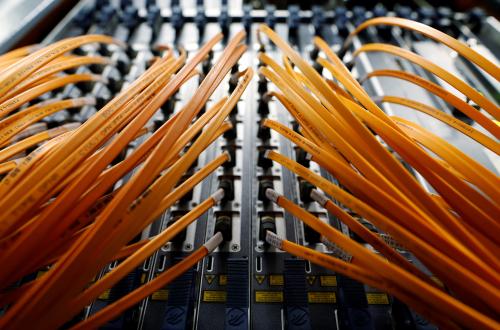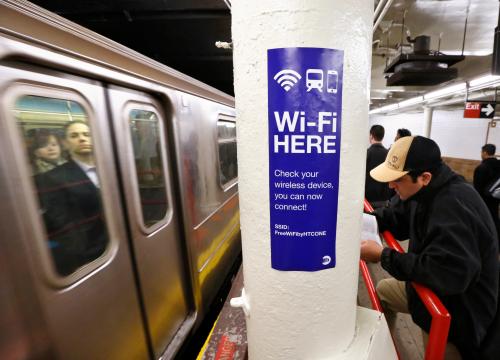This is the third in a trilogy of blogs discussing the state of broadband policy as a new administration and Congress begins. The first summarized three speeches I gave just before and after the election providing a framework for how making America great requires great broadband and discussing approaches to using an infrastructure initiative to address current broadband shortfalls. The second looked generically at the question of how broadband policy is likely to play out in a new Administration. This post focuses on the role of cities in assuring their communities have the foundation they will need to thrive in the 21st Century Global Information Economy.
The federal government has often played a major role in the country’s infrastructure development. With a President who promised federal support for improving infrastructure, we will soon see how the new administration proposes to do so. Based on their approaches to markets broadly, the new administration’s broadband policies are likely to lead to significant deregulation, tax changes, and merger activity that will affect the private sector’s appetite for infrastructure-related investment.
Still, infrastructure deployment is largely dependent on the efforts and policies of cities. In the early part of the last century, cities were the gravitational center for efforts to create the electrical, water, sewer, transportation, and lighting infrastructure required for economic growth and social progress in that time. Subsequently, while telephone service was largely addressed at the state and federal level, cities dealt with the deployment of cable networks and the cellular towers. In the last decade cities have been at the cutting edge of creating a more hospitable environment for deploying gigabit capable networks.
Still, cities face significant challenges related to communications networks. At least three new networks should be on every city’s horizon: next generation mobile, the civic Internet of Things, and a big data capable network. All have in common a need for significantly denser fiber networks than currently exist. A federal infrastructure plan can take a variety of actions to induce the private sector, as well as cities and states, to fill those fiber gaps. Whatever the federal actions, however, these new networks will need smart policies by cities.
Next generation mobile
For the next several years, mobile broadband companies will be completing their fourth generation (4G) networks. But within the Trump Administration, carriers will begin to deploy next generation mobile networks. If we define next generation mobile, as we should, as a network that uses wireless spectrum for the last connection to the device, and that is capable of speeds functionally equivalent to that offered by the best mass-market fixed network, many cities will soon have a next generation mobile network. That network will be the one offered by cable, which has adroitly expanded its fixed wired offering to include Wi-Fi connections both in their subscribers’ homes and in millions of hot spots outside the homes. As cable upgrades its fixed network to its next generation (DOCSIS 3.1) the speeds available on its Wi-Fi networks will increase as well.
But the availability of one network should not be a reason for cities to rest. For one thing, a single monopoly network is unlikely to innovate or price in a way that drives the greatest public good. For another, the cable network may not be as robust as the next generation (fifth generation, or 5G) networks that mobile companies are touting as holding great promise for basic advanced new communication services like two-way 4K video, advanced security and privacy controls, and many other services.
While the promise of 5G is great, so are challenges to deployment. To date, customers have received cellular data from a macro-cell, a large tower that serves a broad area and many customers. 5G customers will receive data from many small cells that serve a smaller area and many fewer customers. 5G radio deployments will be exponentially more numerous and densely distributed. 5G service providers will need to be able to build or lease wireline networks that extend much closer to the customers than required by the current architecture.
This presents daunting economics, significantly higher than previous deployments. It may be cost prohibitive for current or new carriers to build separate wireline facilities to serve their networks. As was true in deploying all communications networks, local governments will impact the economics, overseeing deployment through zoning, permitting and other regulations. It is critical that governments protect the public interest while embracing policies and processes that reduce delays and costs.
The civic Internet of Things
The Internet of Things itself refers to the ability of devices, equipped with far greater computing power and connected to the Cloud and each other through far greater bandwidth, to provide a greater awareness of a situation and to act to improve outcomes. These developments are already having a dramatic impact on how we manufacture goods, in what is generally referred to as the industrial Internet of Things.
The civic Internet of Things is, at one level, simply adding intelligent devices to a number of infrastructure systems generally run by cities, including, but not limited to, water, sewer, power, and transportation. It creates new opportunities to improve the data on which decisions are made in areas such as public safety, public health, and social services. For example, while numerous cities already have security cameras and gunshot recognition sensors, emerging technologies are enabling the same cameras and sensors to automatically detect unusual activities and deliver a rapid response, resulting in a 10 to 30 percent decrease in crime. The civic Internet of Things can reduce electrical outages and water loses, improving all manner of resource management. It can adjust traffic management, improving traffic flow and reducing time spent in cars looking for parking spaces.
McKinsey has estimated that the global economic impact of state and local government use of the Internet of Things as between $930 billion and $1.7 trillion by 2025. Beyond financial improvements, cities are using technology to better inform residents of the state of the city, improve the public dialogue as to city priorities and options, reduce financial barriers to access, by low-income persons and enable new forms of citizen experimentation, science, and entrepreneurship.
Like next generation mobile, the civic Internet of Things will also depend on ubiquitous, fast and affordable communications networks. Thus, while municipalities contemplate how best to facilitate the deployment of 5G networks, they should also consider how to facilitate the deployment of the civic Internet of Things.
Big data networks
In the last several years, incumbent ISPs have gone from dismissing the need for gigabit capable networks as the quest for nothing more than bragging rights to bragging themselves about their ability to meet current and future needs with gigabit capable networks. While we are still early in deploying such networks, the last few years have seen significant progress. The timing is ideal because we are seeing that the rise of big data as an essential input to enterprise customers, including a number of public institutions. For cities to be able to attract and retain certain kinds of enterprises, they will have to have networks capable of delivering and receiving big data.
In short, all communities should wish to work with all stakeholders to lower barriers to entry and enable efficient builds, and provide efficient incentives for the necessary new investment in these three developing and related networks.
Emerging playbooks
But how best to do so? It’s early but several initiatives should provide some insight.
First, newly installed FCC Chair Ajit Pai has announced the formation of a Broadband Deployment Advisory Committee to provide recommendations on how to accelerate the deployment of high-speed Internet access. The focus will be on how “reducing and/or removing” regulatory barriers can facilitate network investment.
Rhode Island already undergoing a similar process, having released in November a RFI designed to help it and its localities develop policies that create a hospitable environment for the next generation network deployments of these networks. (Disclosure: I serve as an advisor to the State in developing the RFI and the policy recommendations that will flow from that process.) The state hopes the process will facilitate a productive dialogue between all stakeholders, resulting in a productive playbook that all can embrace.
Ohio offers a different model. At the end of the session, legislators suddenly amended a bill regulating pet stores by adding provisions limiting the ability of local government to negotiate the installation of small cell and wireless antennas—essential for 5G—on street lights, utility poles, and traffic lights. The key amendment provides cities only 90 days to approve or deny a service provider’s request to attach small cell to existing structures, or erect a new pole for it. Proponents argued this would streamline deployments. Opponents argued that it will unwisely limit local flexibility in addressing rent, zoning, and maintenance issues, and will not allow enough time to the environmental impact studies or public opinion.
Its too early to draw firm conclusions as to what approach will yield the most fruit, though my experience with next generation deployments suggests a few preliminary observations. First, I think focusing only on removing regulatory barriers ignores the critical role that such tactics as network sharing and facilities access will play in improving the economics of deployment. Second, it’s too early to conclude, as Ohio did, that cities have abused their powers and states should rein them in. Now is the time for honest discussion, creative thinking, and experimentation, not power plays. Third, Ohio’s amendments came without notice or public discussion. Pai and Rhode Island’s approach, with a commitment to transparency and involvement of all stakeholders is a better way to to create the political capital necessary for a number of actions the state and cities will need to undertake to stimulate network deployments. Finally, both the Pai and Rhode Island approach will address critical issues on how to stimulate deployments in areas where market forces are insufficient, which Ohio does not.
Carriers are right that they need clarity to proceed with construction. This will not be easy, as the next few years are certain to be full of technological, economic and political uncertainty. For example, will the potential repatriation of offshore funds cause tech companies—the owner of the lion’s share of those profits—to invest in networks? Will deregulation and mergers cause traditional carriers to increase their capital expenditures? Will any new entrants emerge to offer broadband network services? Some argue the answer to all is yes. I am highly skeptical.
But whatever the impact of the federal policies and new technology, cities should take steps to assure all stakeholders have input, to approach the challenges in a holistic fashion, and to develop clear, fair rules. If they fail to do so, they should not be surprised to see states intervene or other cities jump ahead in attracting the kind of economic development and social progress that requires affordable, abundant bandwidth.






Commentary
Cities and broadband, next administration edition
February 9, 2017